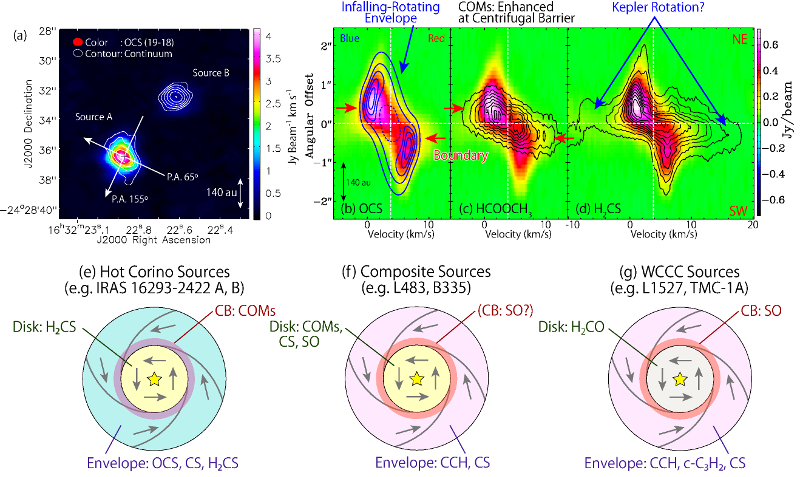
|
EPoS |
|
EPoS Contribution
|
|
Three Cases of Chemical Differentiation in Disk-Forming Regions of Low-Mass Protostellar Sources
Yoko Oya U Tokyo, Tokyo, JP | |
|
Young (Class 0-I) low-mass protostellar sources are known to show significant chemical diversity in their envelopes at a few 1000 au scale. So far, two distinct cases have been known; hot corino chemistry and warm carbon-chain chemistry (WCCC). Hot corino sources are rich in saturated complex organic molecules (COMs), such as HCOOCH3 and NH2CHO, in hot regions in the vicinity of the protostar. Meanwhile, WCCC sources are rich in unsaturated carbon-chain molecules, such as C4H, in warm regions around the protostar. It is of great interest to know how such chemical diversity is inherited to chemistry of disk-forming regions, because it will determine the initial condition for the chemical environment of protoplanetary disks and eventually planets. We here report a new picture of chemical conditions in disk-forming regions found out by ALMA observations.
We investigated the rotational lines of various molecules in several young low-mass protostellar sources with ALMA. The detailed molecular distributions and their kinematics in the disk/envelope system were delineated at a spatial resolution of a few 10 au. We found that the chemical diversity at a few 1000 au scale is indeed delivered into the disk-forming regions at 100 au scale. Moreover, the chemical composition of the gas was found to change drastically from infalling-rotating envelopes to rotationally-supported disks. Figures (a-d) show the case of IRAS 16293-2422 as an example. The kinematic structure traced by the OCS line was well-reproduced by a ballistic model (Figure b). On the other hand, COM lines highlight the boundary between the envelope and the rotationally-supported disk inside it (Figure c). The H2CS line traces both the envelope and the disk components (Figure d). This situation is schematically illustrated as Figure (e). We also found a drastic chemical change in other sources (Figures f, g). Interestingly, it quite depends on their 1000-au-scale chemical characteristics (i.e., hot corino chemistry or WCCC) which physical parts are traced by which kinds of molecules. Such chemical diversity in disk-forming regions has totally been unexpected before ALMA observations. Moreover, we found that L483 and B335 have composite chemical characteristics of hot corino chemistry and WCCC (Figure f). In these sources, the envelope gas is well traced by carbon-chain molecules (CCH) as in the case of the WCCC sources. In addition, emission of saturated COMs concentrating to the closest vicinity of the protostar (i.e. the disk component) was also detected in these sources, just as the hot corino case. Thus, the hot corino chemistry and WCCC are both occuring in a single source, but are spetially separated. This result is consistent with the picture presented by chemical models of collapsing cores. Hot corino chemistry emerges due to evaporation of saturated COMs from dust grains in a hot (> 100 K) region near the protostar, while WCCC is triggered by evaporation of CH4 from dust grains in a warm (> 30 K) region a bit apart from the protostar. Hence, the composite case like L483 and B335 seems to be common occurrence, as predicted by the chemical models. Hot corino sources and WCCC sources so far identified can be regarded as distinct cases, where dust grains are extremely rich in COMs and CH4, respectively. This new chemical view of disk-forming regions will provide us with an important clue to tracing the chmical evolution from protostellar cores to protoplanetary disks. | |
 | |
| Caption: (a) Integrated intensity map of the OCS line (J=19-18; 231 GHz; color) and the 1.2 mm continuum map toward IRAS 16293-2422. (b-d) Position-velocity diagrams of OCS (color), HCOOCH3 (c; contour), and H2CS (d; contour). The position axes are prepared along the white arrow in panel a with the position angle of 65 degree, where the disk/envelope system of Source A is extended. The contours in panel b represent the ballistic model for the envelope component, which well explain the kinematic structure of the OCS line. The `centrifugal barrier' corresponds to the perihelion of the infalling-rotating gas, and it seems to be the boundary between the infalling-rotating envelope and the rotationally-suported disk inside it. The three molecular lines show different distributions (see also panel e). (e-g) Schematic illustrations of the chemical differentiation in disk-forming regions of low-mass protostellar sources. Panels e, f, and g represent the case of hot corino sources, composite sources, and warm carbon-chain chemistry sources, respectively. In all the cases, the chemical composition of the gas drastically changes across the centrifugal barrier of the infalling-rotating envelope. | |
| Collaborators: S. Yamamoto, U Tokyo, JP M. Imai, U Tokyo, JP C. Ceccarelli, IPAG, FR B. Lefloch, IPAG, FR N. Sakai, RIKEN, JP |
Key publication
Suggested Session: Chemistry |